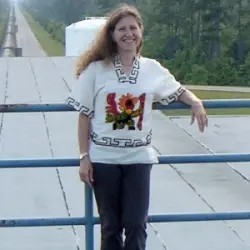Gabriela González
Astrophysicist
Why physics?
First she loved math
Born in Argentina, Gabriela González initially wanted to be a math teacher like her mother. But, when she took her first physics class in high school, she realized that physics was for her.
"I was amazed at how we could ‘explain’ the world with physics and we could predict what objects would do. When I found out this also applied to stars and the universe, and that there were unknown phenomena waiting to be discovered, I decided I couldn’t do anything else!" she says.
Choosing astrophysics
Gabriela pursued her passion for physics at the University of Cordoba, where she completed her "Licienciatura," a degree similar to a master’s degree in the US.
After that, Gabriela moved to Syracuse University for her PhD, which focused on Brownian motion and gravitational waves. Gabriela studied a way to predict thermal noise which could "drown out" the gravitational wave’s extremely small signal. Thus, being able to predict thermal noise becomes important whenever physicists study gravitational waves.
Meet Gabriela
Using physics
Teaching physics and astronomy
Gabriela is currently a professor in the physics and astronomy department at Louisiana State University (LSU). In addition to teaching, she works with the nearby Laser Interferometer Gravitational-Wave Observatory (LIGO) in Livingston, Louisiana.
Studying gravitational waves
In her work at LIGO, Gabriela helps create detectors that will allow scientists to verify the existence of gravitational waves, a phenomenon which can’t be observed directly. When two very large, dense neutron stars collide and merge into one, the force of the collision is so great that it emits ripples, called gravitational waves. These waves eventually reach earth and can provide clues about where they came from and even shed light on the nature of gravity.
The detectors that can pick up gravitational waves are housed in LIGO. These detectors are actually huge versions of a simple device known as a Michelson interferometer. The interferometer splits a beam of laser light, and each piece of light travels down two long perpendicular tunnels that form an "L" shape. At the ends of the tunnels the beams are reflected back to the same point, where they interfere and create unique patterns.
In this case, the perpendicular tunnels are up to 2.5 miles long! Gravitational waves passing through the observatory would cause very small shifts in the length of one of the hallways, changing the interference pattern of the laser light. Seeing a change in the interference pattern would be evidence that gravitational waves actually exist.
"These ripples...were predicted by Einstein almost a century ago, but have never been directly observed yet," says Gabriela. "The LIGO detectors now being built should be able to detect many events per year." She says that the many observations LIGO expects to yield will bring physicists raw data about black holes: "We'll have a completely new kind of telescope to tell us about the life and death of stars."
Advice for students
Strategies for success
Gabriela’s physics training is essential to her work at LIGO and as a professor, but the concepts aren’t the only useful things she has learned. She says, "The best lesson from [my training] was learning to ask questions—always ask ‘Why?!’"
Gabriela also says that learning how to get help from experts, staying on top of the newest developments in your area, and learning how to successfully work with others are very important skills. "I think these skills are very useful for any career in academia, industry or even life, they were certainly very useful for my progress," she says.
You could say that Gabriela takes her work home with her: she’s married to a physics professor who also teaches at LSU, Jorge Pullin. But she takes a little time off from unlocking the mysteries of the universe to experiment with cooking different kinds of ethnic food, including Cajun cooking, which she says has not always been successful. She also enjoys knitting complicated patterns.
Definitions
Brownian motion — Discovered by botanist Robert Brown, this term describes the seemingly random movement of particles suspended in a fluid. Brown was the first to observe a pollen particle exhibiting random movement in water, although he didn’t know what caused it. Now scientists know that Brownian motion occurs when small fluid molecules collide randomly into a much bigger particle.
Gravitational waves — Ripples in the fabric of space and time caused by violent events in the distant universe, including the collision of black holes and supernova explosions.
Thermal noise — When electrons—which carry negative charges—are agitated by heat, they generate "noise" in the form of unwanted currents or voltages that can obscure other signals, like those from gravitational waves.
Neutron stars — Neutron stars are extremely dense, made up only of neutrons, and have gravitational fields that are much stronger than that of Earth. Neutron stars are what remain after a star has undergone a supernova explosion.
Jorge Pullin — Jorge Pullin, Gabriela's husband, is a physicist who has made a career of studying a weighty subject: gravity.
